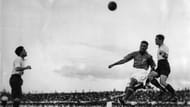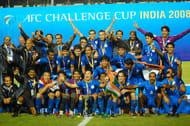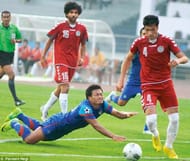When the whole of India is going crazy over the inaugural edition of the ISL, publication of latest FIFA ranking on 27.11.2014 proved to be a dampener. India slipped down to its lowest ever ranking 170.It is obvious from the chart above that India’s FIFA ranking has been on a steady decline since the 90’s.However most people, who have been following Indian team for a while, would agree that the quality of the football in India has in fact improved gradually in the last 7-8 years.
Herein lies the paradox of Indian football for which a number of reasons can be attributed to.
A brief look at the History:
The Golden Age:
After the introduction by the British in the late 19th Century, the game of football in India reached a high in the 50s.
FIFA World Cup, called Jules Rimet Cup then, was still an inconsequential event. Olympic football was the supreme competition of football. At the London Olympics 1948, bare-footed Indians took everyone by surprise and almost caused an upset when they narrowly lost to France by 1-2 in the second round match. The Indian brave hearts, represented by legends like Sailen Manna, P K Banerjee and Neville D’Souza, defeated Dutch giants Ajax in a friendly before returning home.
India again finished a respectable fourth at the 1956 Olympics. Till about mid-sixties, India practically ruled Asian football securing almost all the top titles.
The journey to obscurity
After emerging runners up in 1964 AFC Asian Cup, the Indians were never consistent .In the next 20 years, success was experienced intermittently. India qualified for the 1984 Asian Cup but they could only muster one draw and lost all their matches without scoring a single goal.
The dark period:
The period between 1984 to around 2005 can be called the most ignominious phase of Indian football. Standard of football got stagnant. As nations like Korea, Japan or the Gulf countries made rapid progress, India soon became a continental non-entity. Even within India, its popularity shrunk to a few pockets like Bengal, Goa or Kerala. The only international tournament, the Nehru cup, got discontinued after the 1997 edition.
Matches against even moderately strong sides became a routine humiliation. All the Indian players huddled in their own half, frantically thudding away ball with one hapless I.M Vijayan or Baichung Bhutia getting outnumbered in the opponents half, was a common picture in the 90’s and mid 2000’s.
The second innings:
The year 2006 can be called a watershed in the history of Indian football when veteran Englishman Bob Houghton was appointed as India’s head coach.
Mr. Houghton proved to be a visionary. He infused self-belief and positive attitude into the beleaguered national team. He overhauled the squad and transformed the best available players into a cohesive unit. It was Mr. Houghton’s intransigence that saw the introduction of 5-star treatment for the players, preparatory camps in Europe, world class support staff and a clear pathway for the future.
Passing trapping, speed or stamina of the players improved remarkably. India won the AFC Challenge Cup in 2008, back-to-back Nehru Cups and SAFF Championships, and participated in their first AFC Asian Cup in 2011 after 27 years. However, Houghton had to part ways with India under bitter and controversial circumstances in April 2011 for reasons not entirely related to football.
The post-Houghton Era (2011-2014):
After Bob Houghton, Armando Colaco was appointed as the interim coach from May to September 2011 and he emphasized on passing football. Team India responded well to his coaching methods and rallied to beat host Qatar, ranked 94th then, in a friendly match. However, India bowed out of the 2014 world cup qualifier after being beaten 3-0 by UAE, before holding UAE to a 2-2 draw at home. Armando’s contract was not renewed as he fell out with the AIFF over some issues.
In October 2011, assistant coach Savio Medeira was given the job. Medeira was just about okay and under him India won the 2011 SAFF Cup but in March 2012, lost poorly in all the three matches in the AFC Challenge Cup held in Nepal.
Then Dutchman Wim Koevermans was in charge from June 2012 to Oct 2014. Wim tasted immediate success by winning 2012 Nehru Cup with a win over Cameroon, a team ranked 109 places above India in the FIFA World Rankings. However, India lost to Singapore in a friendly 2-0 in October 2012.
The year 2013 proved to be disastrous. In international friendlies, India lost to Palestine (4-2), Tajikistan (3-0) and drew with Philippines (1-1). Their only win came against Nepal (2-0). India fared miserably even in SAFF cup, 2013 where they were outplayed by even Afghanistan and Nepal.
In the 2014 AFC Challenge Cup qualification matches, India exited the competition after a defeat against lowly-Myanmar. 2014 was even worse under the Dutchman. In friendlies, India were held 2-2 by Bangladesh, suffered defeats against a dilapidated Palestine (2-3) and Pakistan (2-0).
At the Incheon Asian Games, India looked clueless as UAE and Jordan decimated India, 5-0 and 2-0 respectively.
Naturally below par performance for two years running did no good to India’s ranking and it tanked to 170. Wim’s contract was not renewed when it ended in October. Presently hunt for a new manager is on.
Reasons for the downfall:
Lack of foresight:
The success during the “golden age” was due to the personal genius of the legendary coach Syed Abdul Rahim and his talented disciples. After the untimely demise of “the architect of the modern Indian football” in 1963, gradual downslide of Indian football started.
Unbelievably, after Englishman Harry Wright in 1963-1964, there was no permanent manager/coach of the Indian team till 1972. From 1982 to 2006, 14 coaches were changed. Thus, the players could never settle down to a particular style or philosophy.
All this while, world football reinvented itself with modern sports medicine, top notch youth academies and practice facilities. Corporate culture set in along with massive amount of money. On the other hand, Indian football administration became dysfunctional with rampant political interference, nepotism. State and district level organizations became fiefdom of influential and incompetent people with vested interests. Naturally Indian football ran round like a headless chicken with no concerted effort towards betterment.
The Tsunami of cricket:
The 1983 Prudential World Cup win and the 1987 Reliance world cup in India, made cricket a religion in India. With Idols like Kapil Dev, Sunil Gavaskar, Sachin Tendulkar or Sourav Ganguly to name a few, cricket soon devoured the popularity of all other sports, soaking up most of the big time sponsors. Funds dried up for football and severe financial crunch left the AIFF toothless and paralyzed.
Non-existent infrastructure:
Most stadiums and practice facilities in India, till, as recently as, 2010 did not meet FIFA or international standards. The quality of pitches, dressing rooms and spectator amenities were substandard to say the least. Football grounds doubled up as cricket venues and for other functions, causing massive damage to the pitch.
District and state level associations were financially stretched and short of manpower. Training for the coaches and match officials were also poor.
Lack of Youth Development programmes:
Clubs in India started investing a large chunk of their limited budget in recruiting B grade foreign players for instant results. This proved to be counterproductive in the long run. Barring FC Pune or the Bengaluru FC, I-League clubs are yet to have full-fledged youth academies.
Official age based academies came up only in 2012/2013.There are still no official age based league in India. More over Indian Arrows shut shop in 2013 due to lack of sponsors. All these years, the fate of Indian football was in the hands of poor quality local coaching centers and untrained coaches.
On the social front, the glitz and glamour of cricket inspired the youth to descend on the football field with bats and balls. Football became the sports of the hinterland and the needy with very few exceptions. Thus, official and social apathy really proved to be a stumbling block in developing young talents.
The Dutch Debacle:
As the technical director of the Indian team (Nov 2011- Oct 2012), Dutchman Rob Baan brought along compatriot Wim Koevermans as the head coach. Under the Dutch duo Indian team’s performance plummeted.
This was really intriguing. The Dutch company took over when Indian football was just beginning to come out of its slumber. Houghton’s effect on Team India was similar to Sourav Ganguly’s on the cricket team. The I-League kept improving, Indian Arrows somewhat provided a platform for newer talents, IMG-Reliance came aboard. Sepp Blatter’s FIFA and AFC started taking keen interest in India. A very active and enterprising Praful Patel provided substantial back up to the AIFF. Individually Indian players improved quite a lot.
The primary reason for the downfall can be the average performance of Mr. Koevermans. Wim was hardly familiar with ground realities in India. His ideas were mere extension of Houghton’s prescription. However unlike the Englishman, the highly paid coach lacked the acumen or passion to be successful in India.
He switched the formation of Indian side from the classic 4-4-2 and 4-4-1-1 to 4-2-3-1 and it backfired miserably. His player selection lacked courage and innovation. With the retirement of Baichung Bhutia, a lone Sunil Chhetri or less gifted Robin Singh could be seen struggling in opponents’ halves often.
Wim persisted with slow movers like Gourmangi Singh and Raju Gaikwad while leaving out talents like Sandesh Jhingan or Narayan Das or the most experienced and still one of the fittest, Deepak Mondal. Mehtab Hussain, well past his prime and often temperamental, or Arata Izumi did not exactly set the field on fire but were a constant in Wim’s team while Cavin Lobo and Didika were ignored largely. Romeo Fernandes is by far better than the other Fernandes, Francis. The sturdy Dhana Chandra never featured in Wim’s scheme of things. Subhash Singh, TP Rehenesh, Lalrindika Ralte – the list is very very long.
In Sunil Chhetri’s words about India’s recent dismal show in the Incheon Asian games “We were the more defensive ones and playing a 4-5-1 with one striker up front in Robin [Singh] was difficult.”
The ace striker also rued the lack of “quality coaching” in India making things quite obvious. Mediocrity became the hall mark of Wim’s legacy. In about two years, Wim’s coaching eroded whatever gains India had made under Houghton or even Colaco and resulted to a drop in ranking to 170.
However all is not lost yet. The ISL has brought hitherto unseen standard of football to India. Indian players are giving their world class counterparts a run for their money. After FC Bengaluru, another professional corporate entity Kalyani Bharat FC has jumped onto the I-league bandwagon.
Hopefully, with a better coach and a better international fixture, India will dart towards the top 100 mark in a year or so.
Let’s keep our fingers crossed!



